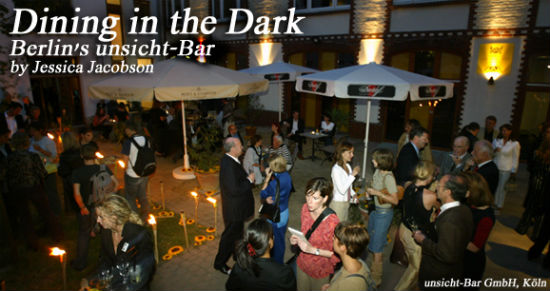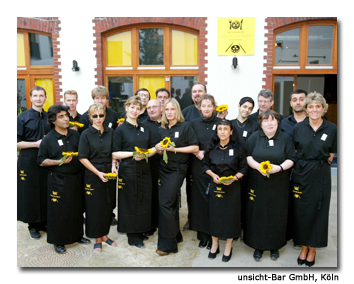

Sandy led us through the doorway into the dining room. We formed a chain. I gripped Sandy’s shoulders, my boyfriend held onto me, and our friend Attila brought up the rear. One moment, we could see. Two steps later, Sandy faded into blackness — intense, inky blackness, like a tight-fitting eye mask.
We were about to have dinner at Berlin’s dunkel restaurant, a dining experience in pure darkness.“If you go this slow, you’ll take all night,” Sandy said, as we shuffled hesitantly behind her. “Remember that I know where we’re going and nothing is in the way.”She was like a bat. Only later would I learn she was sight-impaired. She’d learned to move within a world of darkness. “We’re here,” she said. “And we’ll seat the lady first.”
I felt her reach out and heard a chair moving back from a table. She took my waist and moved me toward the chair, leaving my companions standing alone in the darkness. I sat against a wall and I reached out to feel the edge, covered with Styrofoam.
“And then her man,” Sandy said. Soon I felt Jim’s presence near me. I wiggled my fingers in the darkness, finding his shoulder first, then his hand.
Attila sat across from me. Staring straight ahead, I knew he must be right in front of my eyes. But I couldn’t see a thing.
“You have a knife on your left, a fork on your right, and a spoon at the top of your setting,” Sandy said, and we all ran our fingers across the table, looking for what she described, trying to get our bearings.
My finger touched one piece of icy metal, another, then a third. I knew where to find my utensils. But how to get the food in my mouth would be more challenging.
The restaurant opened in autumn, 2002, and Sandy has worked there since the beginning.
“There was a discussion between a man who was blind and a man with normal vision,” she said. “They thought it would be a good idea to create jobs for sight-impaired people and to give people an experience of what it’s like to not see.”
The idea behind the restaurant is that the loss of sight heightens other senses, allowing diners to appreciate their meal in a new way.
Visitors are led into a lobby with natural light, supplemented by the flickering flames of small candles. Staff hand them menus and ask them to choose between the short and mysterious descriptions. The choices include poultry, lamb, veal, fish, game, and vegetarian menus, costing an average of 45 euros.
But poetic descriptions hide the actual contents, leaving open the question of what will actually appear on one’s plate. A vegetarian appetizer is described as, “A bowl full of lusciousness with a natural snake bite antidote.” The dessert following the veal was described as “Creamy white, bruised by cupid’s red lips – he just had a mint.”
After ordering, a sight-impaired server leads diners into the dining room, where windows covered with wood and velvet submerge everyone in a sea of blackness.
Our experience began with lots of laughter and disbelief as we adjusted to our new environment. I heard other diners as though they were in a different world, even though I knew they were nearby. Soft music piped through the dining room via a radio. I opened and closed my eyes to no effect.
“This would be a good place for blind dates,” Attila joked.
Sandy brought our drinks and set them down carefully, making sure we’d remember their locations. Then she put a breadbasket in the center. Our fingers, crawling over the basket’s edges, found soft rings of baguette bread.
Soon followed our appetizers and our first challenge – salads for Jim and Attila, soup for me.
“Hey, there’s something hard in my salad,” Jim exclaimed.
“I think it’s a walnut,” Attila guessed.
Jim, afraid to eat unknown food, a quality that distinctly hinders the experience of dark dining, passed it to me. It was a cucumber.
I had a spicy soup with shrimp and some other unidentifiable objects. I ate cautiously, dipping my spoon into the bowl, leaning down, and imbibing. A strong and magical smell danced up into my nostrils.
True, the lack of sight brought me closer to my soup, made me notice better its scent and texture.
While eating, we listened to the creaks and groans of chairs, the occasional crashes, a drink spilled at a neighboring table. Sandy would make some noise on her arrival, to not frighten us into knocking something over.
Sandy handed me a small, ceramic round dish.
“What is it?” I asked.
“Manioc.”
I found little chips that tasted like potatoes and were great to eat with fingers.
I used the finger-licking method for my main course as well. Since I couldn’t see where my food was, I couldn’t aim for particular items. So I explored the textures – the soft, ribbed skin on three squares of fish, the spice granules on the soft, round manioc chips, the firm, smooth long shapes that tasted like asparagus.
I gained a new appreciation for custard with fruit as I slid my fingertips over the crusty, caramel crust, down the smooth gelatinous sides, into the cream pooled at the base of the plate.
I ate less than usual, surprisingly full from the initial soup. I realized what an impact looking at food has on inspiring one to eat it. Without sight, one focuses only on the sensation of hunger. Jim left his plate of rich and tender game largely untouched, paralyzed by the stress of not being able to control what he put in his mouth.
There were long pauses between the courses, during which we began to feel hot, sticky and uncomfortable. Attila stood up.
“The ceiling is high,” he said, as he unsuccessfully tried to reach it. He felt the need to move, but felt trapped. Sandy told us to call for her if needed. Attila began to call, low but with a cry for help, “Sandyyy!”
At the end of the meal, Sandy stood us up and we formed the snake-like line again, shuffling across the dining room. We reentered the lobby, two hours later, groggy and with blurred vision, but relieved by the sight of glittering candle flames.
“Do you ever have anyone freak out?” I asked the cashier.
“Yes, about one in a hundred.” With 50 guests per night on average, that would be one case every other night. “We just talk to them and explain things to them,” she said. “There is nothing else we can do.”

Stepping outside into the warm, late summer evening, we admired the pastel building, brightly-colored graffiti panel that had been completed during our dinner, and the welcoming pale sky.
“I’m never going to appreciate the outdoors so much,” Attila said.
If You Go
unsicht-Bar
www.unsicht-bar-berlin.com
Jessica Jacobson is a writer and explorer who has visited more than 50 countries. She is the author of the forthcoming Roaming Kyrgyzstan: Beyond the Tourist Track. She has also written a guidebook to Siberia, Roaming Russia, and published articles in various newspapers and magazines. She’s currently working on a memoir about her time as the first Western resident of a Siberian indigenous community. She blogs about her travels at www.jjstravels.blogspot.com.
- How to Get Around in Sydney: A Local’s Guide to Traveling Around Sydney - April 24, 2024
- The Low-Key Magic of Ghent, Belgium - April 22, 2024
- Discover the Hidden Charm of Extremadura in Spain - April 20, 2024
